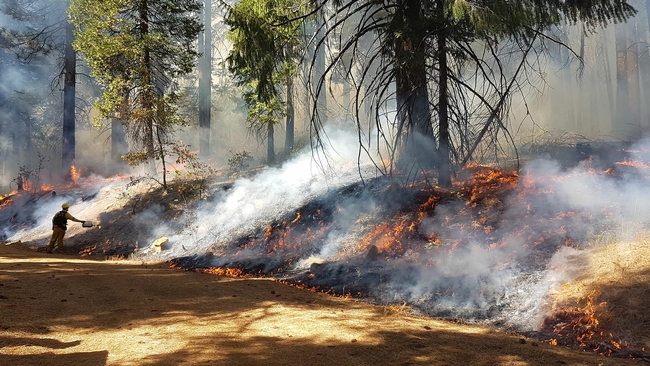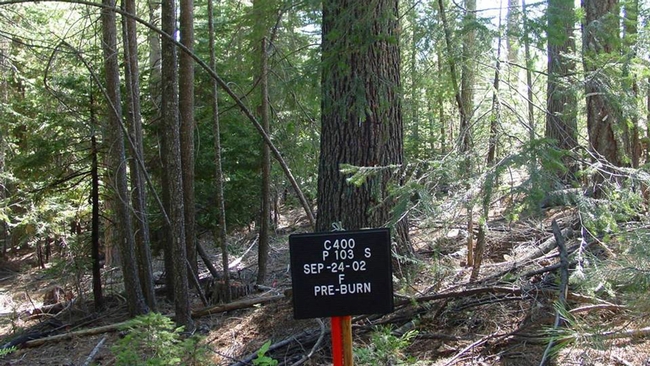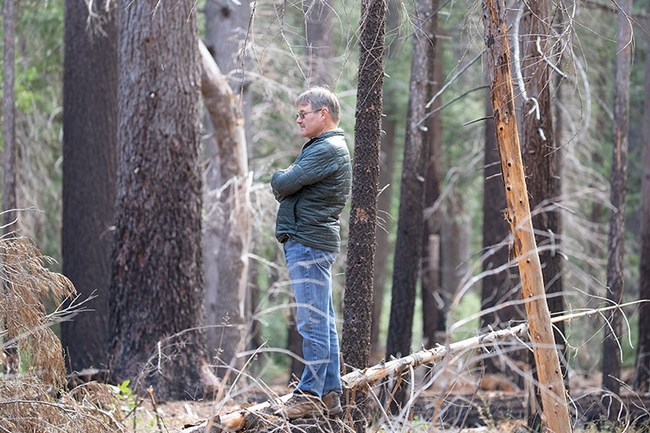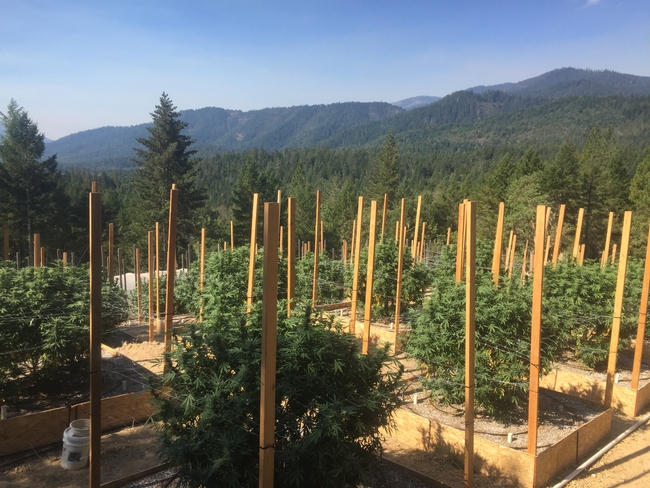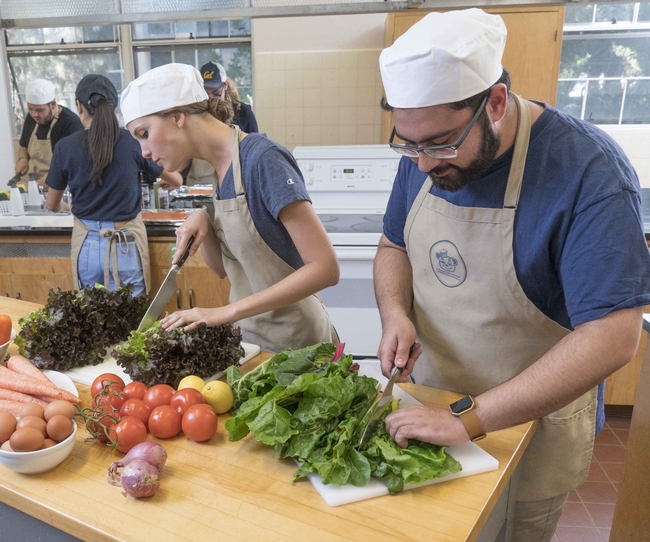
Posts Tagged: Berkeley
Meet 'The Moth Man' at Bohart Museum's Moth Night
Meet "The Moth Man." If you attend the Bohart Museum of Entomology's annual Moth Night celebration, affiliated with National Moth Week, you'll meet John De Benedictis, better known as “The Moth Man.” The indoor-outdoor event, free and open to the public, is set from 7 to 11...
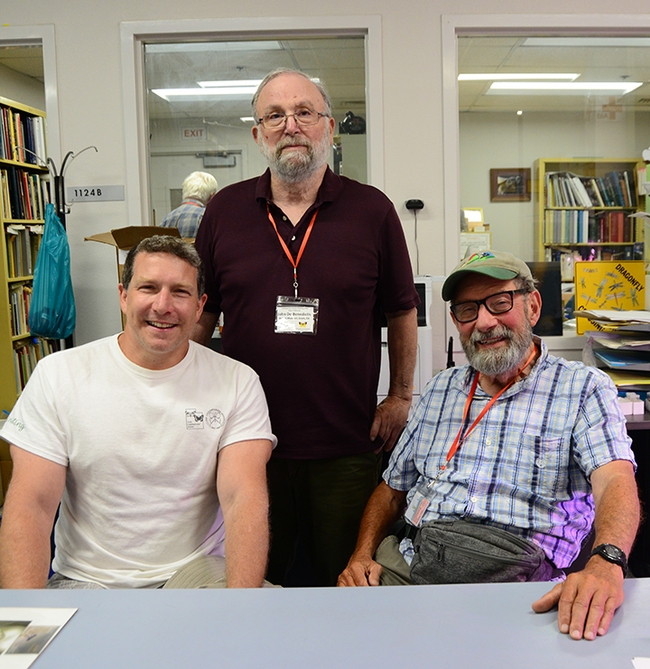
These three entomologists were trained directly or indirectly by Jerry Powell (1933-2023) of UC Berkeley. From left are Dan Rubinoff, John De Benedictus and Paul Opler (1938-2023) at a gathering of lepidopterists in 2019 at the Bohart Museum of Entomology. Powell and Paul Opler (1938-2023) co-authored Moths of Western America, published in 2009. (Photo by Kathy Keatley Garvey)
20-year study confirms California forests are healthier when burned or thinned
Surrogates to wildfire
Trial by fire
Exploring the complexities of cannabis farming in rural areas
Land use change in agricultural frontiers can have far-reaching social and environmental implications, such as habitat loss, water contamination, or worker demographic shifts — particularly when it involves the rapid expansion of a new industry such as cannabis production. A recent study published in Landscape and Urban Planning offers an interdisciplinary perspective on the drivers of cannabis production in rural areas, using interviews with farmers and spatial modeling to uncover key factors.
Led by researchers from UC Berkeley's Department of Environmental Science, Policy, and Management (ESPM) and the Cannabis Research Center, the article “Where money grows on trees: a socio-ecological assessment of land use change in an agricultural frontier” provides a social-ecological systems approach for assessing drivers of cannabis production in Southern Oregon, using interviews with farmers and spatial modeling to uncover key factors.
"Unlike other crops, we have less understanding of where and how cannabis is grown, making it an important area of ongoing research," said Van Butsic, a professor of cooperative extension in ESPM and the senior author of the study.
The researchers interviewed 14 cannabis farmers to identify major themes around their relationships with land use, and used those themes to generate predictors for models of land use change. Most of the interview-derived drivers were significantly associated with cannabis distribution and development, including parcel size, human footprint, distance to the nearest cannabis farm, the density of local cannabis production, clearable land cover, farm zoning, elevation, roughness, and distance to rivers. The interview data also provided insights into the relationship of cannabis with social and environmental dynamics.
“We gained many insights from the interview data,” said lead author and ESPM postdoctoral scholar Phoebe Parker-Shames. “For example, we knew from previous research that cannabis development tends to be clustered, but we understand a little better now that this is related to the ways in which cannabis farmers rely on each other to share knowledge, labor, and navigate uncertainty during difficult policy changes.”
One of the major themes that emerged from the interview data was the environmental stewardship values of the farmers. “There is a large untapped potential for education and management outreach to target farmers who got into this industry in part because of their ability to connect with the land,” Parker-Shames said. “The farmers we spoke to had a genuine desire to learn best practices in an industry without a lot of formal standards for production. I'm grateful that they were willing to share their experiences and insights with us.”
Additional Berkeley co-authors include ESPM professor Justin Brashares and alumni Hekia Bodwitch (PhD '17 ESPM). The study's findings provide valuable insights into the drivers of cannabis production and the environmental stewardship values of cannabis farmers, which can inform environmental policy, regulation, and best practices for sustainable cannabis production.
Residents’ water security concerns could spur climate adaptations
Study: Climate impacts widespread across California, fueling worries over water supply
As water system managers across California devise strategies to help secure their water supply, they often face a major obstacle to implementing those measures: a lack of interest or will to act among community members.
“One of the things that the literature has found is that even if water system managers and local decisionmakers are really worried about climate change and water security, a lot of the adaptation strategies that they have in their toolbox actually require support from residents,” said Kristin Dobbin, a UC Cooperative Extension specialist focused on water justice planning and policy.
Because popular support is essential for realizing many water-related adaptations – from changing the rate structure to approving bonds for new infrastructure – Dobbin and her colleagues recently published a paper looking deeper at residents' experiences of, and concern about, climate impacts to household water supply.
Through a drinking water-focused portion of a long-term panel survey administered by California State University, Sacramento, scholars in the Household Water Insecurity Experiences research network had the opportunity to query Californians on how they are experiencing the climate crisis at their taps. Specifically, the researchers sought to analyze respondents' perceptions of future climate risks to water security.
“As a group that studies drinking water access in California, we're often looking at the system level and community level,” said Dobbin, based at the UC Berkeley Department of Environmental Science, Policy and Management. “So it was exciting to dive into the household level and understand what's happening at a more individual level.”
Climate impacts seen ‘up and down the state'
The statewide survey, conducted in spring 2021, elicited 704 responses from the panelists, representing every census region in the state and nearly every county. More than one-third (34%) of respondents said that their water supply had been affected by an extreme weather event in the past five years. Given the timing of the survey, drought was unsurprisingly the most frequently mentioned impact. Importantly, these climate impacts were felt across California.
“There is an inclination to assume that drought and other impacts are a geographically bounded issue, but what we really see is that is not the case,” Dobbin said. “These impacts are happening up and down the state, all the way to the Oregon border.”
Overall, 85% of respondents reported that they were concerned about the long-term reliability of their water supply. Crucially, the study also indicated that residents were making the connection between climate impacts and risks to their future water security.
“The more impacts they reported, the more concerned they were about future supply and reliability,” said study co-author Amanda Fencl, a senior climate scientist with the Union of Concerned Scientists.
Droughts and heat waves, in particular, seem to increase residents' concerns over water supply the most. Dobbin suggests that framing the need for water-security adaptation strategies around those specific weather events could be particularly useful in marshaling community support.
Knowing the level of concern within the community – and understanding the best way to convey the urgency of climate adaptation measures – could be a boon for local managers seeking to gain public backing for more expensive water projects. Such projects might include self-sufficiency measures that reduce reliance on imported water from other parts of the state.
“That could bolster some water managers to have more confidence in using climate change and extreme events as a way to motivate ratepayers to get on board with these bigger investment decisions,” Fencl said.
Study highlights avenues for more research
While flooding barely registered as a climate impact in the 2021 survey results, Dobbin said that the responses would likely be very different today, after atmospheric rivers inundated the state this past winter. Floodwaters can damage water treatment plants – and storms can knock out power to private wells and larger water system treatment and distribution facilities.
In fact, from the 2021 survey, power outages due to utilities' wildfire prevention policies were the climate impact most frequently mentioned in the “other” category, highlighting for researchers the need to consider and plan for the interconnectedness of water and power systems.
“People forget about the interplay between a reliable electric grid and the ability to run water in your house and the ability for water systems to pump and treat water,” Fencl explained. “When we think about disaster response and disaster preparedness, we need to be a bit more holistic.”
The researchers also pointed to significant differences in experiences of climate impacts across gender and racial demographics, with Latino, Asian American Pacific Islander and LGBTQ+ respondents reporting higher rates of impacts. Given the relatively small sample sizes, however, Fencl said there needs to be larger – and more inclusive – surveys to get a clearer picture of those disproportionate impacts.
Even still, Dobbin added that their study serves as a reminder for scholars, water managers and policymakers to re-center community members, in all their diversity, as key players in the push for more effective and sustainable climate adaptation strategies.
“One of the takeaways from the paper is that we can't forget about the role of the public in this conversation – and we can't bypass the public,” Dobbin said. “The bottom line is that most of the adaptations that we have available to us require some level of residential involvement.”
In addition to Dobbin and Fencl, authors of the study, published in the journal Climatic Change, include Gregory Pierce, UCLA Luskin Center for Innovation; Melissa Beresford, San Jose State University; Silvia Gonzalez, UCLA Latino Policy and Politics Institute; and Wendy Jepson, Texas A&M University.
Teaching Kitchen course helps improve college students’ food security
Cooperative Extension researcher: Nutrition course a boon for UC Berkeley students
College students across the nation are struggling to meet their basic food needs. Within the University of California system of 280,000 students, 38% of undergraduate students and 20% of graduate students report food insecurity.
As part of the UC Global Food Initiative, in 2015 the Nutrition Policy Institute (a UC Agriculture and Natural Resources statewide research center) identified student food insecurity as a UC systemwide problem, prompting the UC Regents and campuses to collectively address the issue.
All 10 UC campuses now have on-site basic needs centers, providing food, emergency housing and support services. The UC system and campus working groups recognize that meeting basic needs, such as food, is a multidimensional challenge.
In response to the 2022 White House Conference on Hunger, Nutrition, and Health, which called for national efforts to reduce diet-related disease and food insecurity, UC renewed their commitment to cut the proportion of students facing food insecurity in half by 2030. Campuses will partner with local counties to maximize enrollment in the Supplemental Nutrition Assistance Program (also known as CalFresh in California), provide food for students who do not qualify for CalFresh, and allocate campus food resources to historically underserved student populations.
NPI's collaborative researchers continue to monitor the impact of these efforts, in addition to other interventions, such as supporting students in building basic culinary skills, to improve food security. One multipronged approach to address food insecurity at UC Berkeley is a 14-week course on Personal Food Security and Wellness with a Teaching Kitchen laboratory component.
Sarah Minkow, who teaches the Personal Food Security and Wellness course at UC Berkeley, shared that students learn about nutrition and gain culinary skills through the Cal Teaching Kitchen.
The curriculum is designed with consideration for the time, cost and convenience of healthy eating. Discussions include food safety, calculating nutrient needs, mindful eating and reading nutrition labels. The Teaching Kitchen laboratory brings the lessons to life through knife skills, “no-cook” cooking, microwave cooking and sheet pan meals.
Minkow enthusiastically highlighted her students' “overwhelmingly positive [response to the] lecture and lab,” suggesting the benefits of an interactive learning environment to garner student engagement.
“Students often give feedback that they wish this was a required course for all UC Berkeley students,” said Minkow. She noted one barrier to reaching more students: capacity of the Teaching Kitchen space.
Susana Matias, a Cooperative Extension specialist at the UC Berkeley Department of Nutritional Sciences and Toxicology and collaborative researcher with the NPI, evaluated the impact of the Personal Food Security and Wellness course at UC Berkeley.
Matias reported that increasing food literacy and culinary skills among students has shown to increase intake of fruits and vegetables, and frequency of cooking, and reduce the number of skipped meals. Her study on the impact of the 14-week nutrition course also found a significant decrease in student food insecurity.
Across the UC System, students are benefiting from their campus Teaching Kitchens, including UC Berkeley, UC Davis, UCLA and UC Riverside. Other campuses such as UC San Diego, UC San Francisco, UC Santa Cruz and UC Santa Barbara offer basic student cooking classes as well.
Katherine Lanca, UC Global Food Initiative fellow working with NPI, attended the 2022 Teaching Kitchen Research Conference as part of her fellowship to learn about the latest research on teaching kitchens supporting equitable health outcomes.
The conference was hosted at UCLA by Harvard T.H. Chan School of Public Health Department of Nutrition in association with the Teaching Kitchen Collaborative. Teaching kitchens are a promising approach to supporting food security and cultivating lifelong habits, especially among a college student population.

